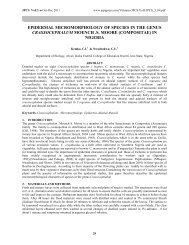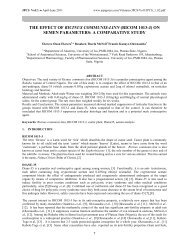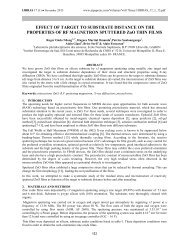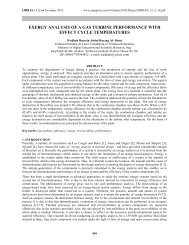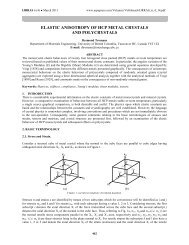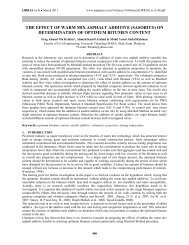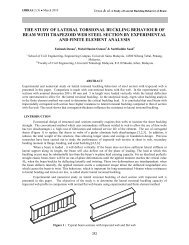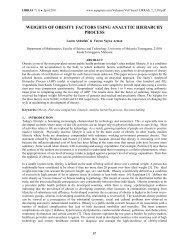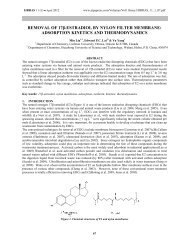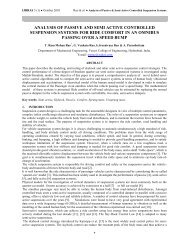IJRRAS ● August 2010 Rezaei & al. ● <strong>Two</strong>-dimensional <strong>Cutt<strong>in</strong>g</strong> <strong>Stock</strong> Managment In the studied examples, the algorithm was term<strong>in</strong>ated based on the first condition before meet<strong>in</strong>g the second term<strong>in</strong>ation condition of the algorithm. .However, <strong>in</strong> order to evaluate the amount of waste <strong>in</strong> cutt<strong>in</strong>g process, we considered another variation where the first term<strong>in</strong>ation condition was ignored and we <strong>in</strong>vestigated a number of different cases. As described <strong>in</strong> table 1, the waste was controlled <strong>in</strong> order to make a proper decision <strong>in</strong> case of a sudden change. Table 1- Review the best condition with 10pants The results based on the second term<strong>in</strong>ation condition are shown <strong>in</strong> Figure 2. Figure 2- Achieve to the second stop condition and stop the problem As shown <strong>in</strong> Figure 2, percentage of waste for 7 pants 0.61% is higher than that for 6 pants, and the algorithm stopped at 7 pants. 8. CONCLUSION The algorithm was stopped because the situation will be worse <strong>in</strong> 7 pants. It means that reached to second stop condition. In this paper we studied the two-dimensional cutt<strong>in</strong>g stock problem to reduce cutt<strong>in</strong>g stock. Most of researchers have studied cutt<strong>in</strong>g stock problems with the aim of reduc<strong>in</strong>g waste <strong>in</strong> the sheet with specified length and width. But <strong>in</strong> this research, only the width is specified and an unlimited length is assumed for the fabric from which the pieces were cut. This turns uncontrollable wastes <strong>in</strong>to controllable ones with displacement of the length, dist<strong>in</strong>guish<strong>in</strong>g the studied method is different from those studied until now. It is difficult and impractical to utilize a general model for the problem, s<strong>in</strong>ce there is an extremely large number of comb<strong>in</strong>ations of cutt<strong>in</strong>g styles. In such problems, to achieve the near optimum solution, simulated anneal<strong>in</strong>g is one of the most effective metaheuristic algorithms 248
IJRRAS ● August 2010 Rezaei & al. ● <strong>Two</strong>-dimensional <strong>Cutt<strong>in</strong>g</strong> <strong>Stock</strong> Managment This research has been done on men’s cloth<strong>in</strong>g (male pants size 42) and the patterns were enclosed by rectangular shapes and irregular shapes changed to regular one. To obta<strong>in</strong> numerical result <strong>in</strong> this research, we assume unlimited length of fabric, and <strong>in</strong>controllable waste was changed <strong>in</strong>to controllable and concentrated ones, which can be used <strong>in</strong> future consumptions. 9. REFERENCES [1] Alan, R. M.J., Shang, J. and Kuppusamy, S., 2006, "Simulated anneal<strong>in</strong>g heuristics for the dynamic facility layout problem", Computers & Operations Research, 33, 2431-2444. [2] Beasley, J.E, 1985, “Algorithms for Unconstra<strong>in</strong>d <strong>Two</strong> <strong>Dimensional</strong> Guillot<strong>in</strong>e <strong>Cutt<strong>in</strong>g</strong>,” Operations. Research Society, 36 (4), 297-306. [3] Gilmore, P.C. and Gomory, R.E., 1963, A l<strong>in</strong>ear programm<strong>in</strong>g approach to the cutt<strong>in</strong>g stock problem-part II- Operation Research, 11, 863-888 [4] Karelahti, J., 2002, Solv<strong>in</strong>g the <strong>Cutt<strong>in</strong>g</strong> <strong>Stock</strong> Problem <strong>in</strong> the Steel Industry. Hels<strong>in</strong>ki University of Technology, 1-39. [5] Kirkpatrick, S., Gelatt, C. D., Vecchi, M. P., 1999. Optimization by Simulated Anneal<strong>in</strong>g, Science, 220 , 671- 680 [6] Maniezzo, V., and Carbonaro, A. 1999. Ant colony optimization: an overview. Knowledgen and Data Eng<strong>in</strong>eer<strong>in</strong>g, 11, 769–778. [7] Michalewicz, Z., 1994. Evolutionary computation techniques for nonl<strong>in</strong>ear programm<strong>in</strong>g problems. International Transactions of Operational Research, 1, 223–240. [8] Umetani, S. and Yagiura M., An LP-based Local Search for One <strong>Dimensional</strong> <strong>Cutt<strong>in</strong>g</strong> <strong>Stock</strong> Problem. The Fifth Metaheuristics International Conference. [9] Sta<strong>in</strong>ton, R. S. 1977. The cutt<strong>in</strong>g stock problem for the stockholder of steel re<strong>in</strong>forcement bars. Operational Research Quarterly, 28, 139–149. [10] Tavakkoli-Moghaddam, R., Safaei, N. and Shariat, M.A.., 2005, A multi-criteria vehicle rout<strong>in</strong>g problem with soft time w<strong>in</strong>dows by simulated anneal<strong>in</strong>g, International Journal of Industrial Eng<strong>in</strong>eer<strong>in</strong>g, 1(1), 28-36. [11] Aarts E. and Korst J, 1989, Simulated anneal<strong>in</strong>g and boltzmann mach<strong>in</strong>es: a stochastic approach to comb<strong>in</strong>atorial optimization and neural comput<strong>in</strong>g , Wiley, Chichester [12] Smith K. I., 2006, A Study of Simulated Anneal<strong>in</strong>g Techniques for Multi-Objective Optimization, University of Exeter, PhD Thesis. [13] Holland, J. H., 1975, Adaptation <strong>in</strong> Natural and Artificial Systems, University of Michigan Press, Ann Arbor, MI. [14] Goldberg, D.E, 1975, Genetic Algorithms <strong>in</strong> Search, Optimization and Mach<strong>in</strong>e Learn<strong>in</strong>g, Addison Wesley, Boston, MA. [15] Glover, F., 1977, Heuristic for <strong>in</strong>teger programm<strong>in</strong>g us<strong>in</strong>g surrogate constra<strong>in</strong>ts, Decision Sciences, 8 (1) 156– 166. [16] Kirkpatrick, S., Gelatt, C. and Vecchi, M., 1983, Optimization by simulated anneal<strong>in</strong>g, Science 220 (4598), 671–680. 249



